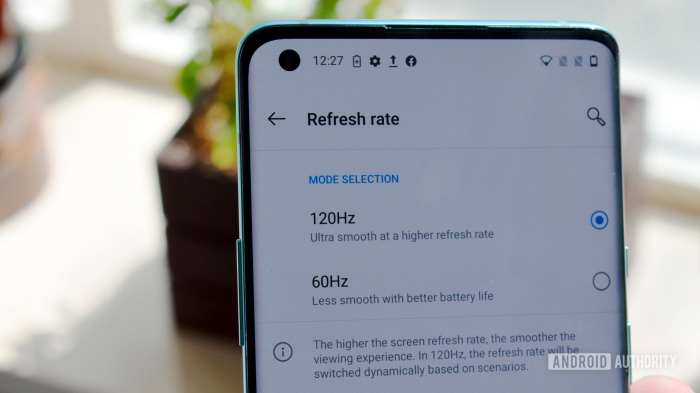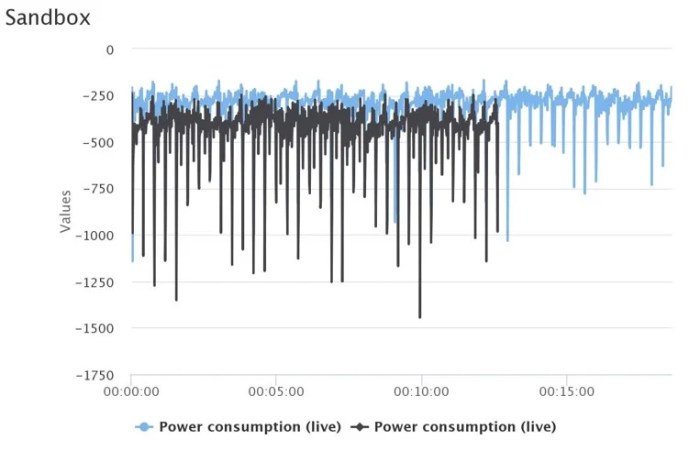Long term effects of high refresh rate phone screens – Long-term effects of high refresh rate phone screens are a growing concern. While these screens offer smoother visuals and improved responsiveness, prolonged use may impact various aspects of health, from eye strain and sleep quality to cognitive function and even mental well-being. This exploration delves into the potential consequences of constantly engaging with these advanced displays, examining both the immediate and long-term effects on our physical and mental health.
The increasing prevalence of high refresh rate displays in smartphones necessitates a comprehensive understanding of their potential impact. This investigation aims to provide a balanced perspective, considering both the advantages and disadvantages, and offering practical strategies for mitigating potential risks associated with prolonged usage. We will explore the scientific evidence surrounding eye strain, sleep disruption, cognitive effects, and other potential health implications.
Eye Strain and Fatigue: Long Term Effects Of High Refresh Rate Phone Screens

High refresh rate screens, while offering smoother visuals and improved responsiveness, may contribute to increased eye strain and fatigue in some users. The mechanisms behind this are complex and not fully understood, but several factors likely play a role.
The potential mechanisms by which high refresh rate screens contribute to eye strain and fatigue involve several factors. Firstly, the increased visual stimulation from the rapidly changing images can lead to greater demands on the eye muscles responsible for focusing and accommodation. This constant adjustment can result in fatigue and strain, particularly during prolonged screen use. Secondly, the brighter, more vibrant displays often associated with high refresh rate screens can increase glare and light sensitivity, further exacerbating eye strain. Finally, some individuals might experience discomfort due to the subtle but persistent flicker associated even with high refresh rates, although this is less pronounced than with lower refresh rates. The interplay of these factors contributes to the overall experience of eye strain and fatigue.
Comparison of Eye Strain Levels
Studies comparing eye strain levels between users of high and low refresh rate screens have yielded mixed results. Some studies report a slightly increased incidence of eye strain among users of high refresh rate displays, particularly after extended periods of use. However, other studies have found no significant difference. This discrepancy may be due to several factors, including variations in study methodologies, the types of screens used, and individual differences in visual sensitivity and susceptibility to eye strain. More robust and standardized research is needed to definitively establish the relationship between screen refresh rate and eye strain.
Mitigating Eye Strain from High Refresh Rate Displays
Several strategies can help mitigate eye strain associated with high refresh rate displays. These include following the 20-20-20 rule (every 20 minutes, look at an object 20 feet away for 20 seconds), adjusting screen brightness to a comfortable level, reducing glare through proper lighting and screen positioning, and ensuring the screen is at the correct distance from the eyes. Using blue light filtering software or glasses can also help reduce eye strain by filtering out harmful blue light emitted from the screen. Regular breaks from screen time and maintaining good posture are also crucial for preventing eye fatigue. Finally, if eye strain persists despite these measures, consulting an optometrist or ophthalmologist is recommended to rule out underlying vision problems.
Headaches and Migraines

High refresh rate screens, while offering a smoother visual experience, have raised concerns regarding potential negative impacts on users’ health. One such concern is the increased risk of headaches and migraines. While research is still ongoing and definitive conclusions are lacking, several mechanisms might explain this potential link.
High refresh rate screens, particularly those with poorly implemented motion interpolation techniques, can introduce subtle visual artifacts and flickering that are imperceptible to some but can trigger headaches or migraines in susceptible individuals. These artifacts might strain the eyes more intensely, leading to discomfort and pain. The constant rapid changes on the screen may also overstimulate the visual cortex, resulting in neurological consequences such as headaches. Furthermore, increased screen time, often associated with high refresh rate devices due to their appealing visual quality, is a known risk factor for headaches independently of refresh rate.
Potential Mechanisms Linking High Refresh Rate Screens and Headaches/Migraines
The exact mechanisms by which high refresh rate screens might trigger or worsen headaches and migraines are not fully understood. However, several hypotheses exist. One is the potential for increased eye strain due to the rapid refresh rate. This constant visual stimulation can lead to fatigue and discomfort, potentially triggering headaches. Another hypothesis centers on the potential for subtle flickering or visual artifacts, even with high refresh rates, which can be irritating to the visual system and act as a trigger for migraines in susceptible individuals. Finally, increased screen time associated with high refresh rate displays could independently contribute to headaches, as prolonged screen use is already a known risk factor.
Prevalence of Headaches and Migraines Among Users of Different Screen Refresh Rates
Currently, there’s a lack of large-scale, controlled studies directly comparing the prevalence of headaches and migraines among users of different screen refresh rates. Existing research focuses more on the overall effects of screen time and digital eye strain. Therefore, it is difficult to definitively state the prevalence of headaches and migraines among users of different refresh rates. Future studies are needed to establish a clear correlation. However, anecdotal evidence suggests a potential link, with some users reporting increased headache frequency after switching to higher refresh rate screens. This observation requires further investigation to confirm and quantify the relationship.
Comparison of Symptoms and Triggers of Headaches and Migraines Potentially Related to Screen Refresh Rate
The symptoms of headaches and migraines can overlap, making it challenging to differentiate them solely based on symptoms. However, some distinctions exist. The table below summarizes potential symptoms and triggers related to screen refresh rate, though it’s crucial to remember that these are potential associations, not definitive causal relationships.
| Symptom/Trigger | Tension Headache (potentially related to screen refresh rate) | Migraine (potentially related to screen refresh rate) |
|---|---|---|
| Pain Location | Tightness or pressure around the head | Throbbing pain, often on one side of the head |
| Pain Severity | Mild to moderate | Moderate to severe |
| Duration | 30 minutes to several hours | 4 to 72 hours |
| Associated Symptoms | Muscle tension in the neck and shoulders, tenderness to the touch | Nausea, vomiting, sensitivity to light and sound (photophobia and phonophobia) |
| Potential Triggers (related to screen refresh rate) | Eye strain from prolonged screen use, visual artifacts from high refresh rate screens | Flickering or visual artifacts from high refresh rate screens, stress from prolonged screen use |
Effects on Visual Acuity

The increasing prevalence of high refresh rate screens in smartphones and other devices raises concerns about their potential long-term effects on visual acuity. While the immediate benefits of smoother scrolling and reduced motion blur are appealing, the impact of prolonged exposure to these displays on eye health remains a subject of ongoing research and debate. This section will explore the potential consequences of high refresh rate screens on visual acuity, comparing individuals with varying levels of exposure and summarizing relevant studies.
While there’s no conclusive evidence currently linking high refresh rate displays to a significant decline in visual acuity in healthy individuals, several factors warrant consideration. The higher refresh rate itself doesn’t directly damage the eye, but related behaviors and potential indirect effects are relevant. For example, increased screen time associated with the appealing visual experience could lead to digital eye strain, which, if chronic, might contribute to long-term visual issues.
Potential Mechanisms for Visual Acuity Impact
The potential for high refresh rate screens to affect visual acuity isn’t through a direct mechanism of damage, but rather through indirect pathways. Increased screen time, a likely consequence of the more enjoyable viewing experience, can lead to prolonged near-work activity. This, in turn, can contribute to the development of myopia (nearsightedness) and other refractive errors. Furthermore, the brighter, more vibrant displays often associated with higher refresh rates might lead to increased exposure to blue light, a factor also linked to potential eye strain and long-term visual health concerns. Studies are needed to specifically isolate the impact of refresh rate from other factors like screen brightness and overall screen time.
Comparative Studies on Visual Acuity
Direct comparative studies focusing solely on the impact of high refresh rate screens on visual acuity in healthy individuals are limited. Many studies on digital eye strain encompass a range of screen technologies and usage patterns, making it difficult to isolate the effect of refresh rate. However, studies comparing individuals who spend significant time using high refresh rate devices versus those who primarily use lower refresh rate screens might show subtle differences in reported eye strain or visual fatigue, though not necessarily a direct impact on objectively measured visual acuity. Future research focusing on controlled, long-term studies with larger sample sizes is needed to definitively determine any correlation.
Summary of Relevant Studies
Currently, a comprehensive meta-analysis specifically addressing the long-term effects of high refresh rate displays on visual health is lacking. Existing research primarily focuses on digital eye strain and its associated symptoms, often without distinguishing the specific impact of refresh rate. Many studies acknowledge the need for further investigation into the long-term effects of high refresh rate displays on various aspects of visual health, including visual acuity. The available literature largely highlights the need for more rigorous research with larger sample sizes and controlled experimental designs to fully understand the potential impacts.
Digital Eye Strain

Digital eye strain is a common ailment characterized by discomfort and fatigue in and around the eyes, often stemming from prolonged screen use. While many factors contribute, high refresh rate screens, while offering smoother visuals, can also play a role in exacerbating digital eye strain in susceptible individuals. The increased visual stimulation, though often perceived as positive, can lead to increased eye muscle activity and potentially heightened strain.
Digital eye strain from high refresh rate screens manifests similarly to strain from other sources, but the underlying mechanism might differ subtly. Symptoms often include blurry vision, dry eyes, headaches, neck and shoulder pain, and eye fatigue. The rapid image transitions on high refresh rate screens may contribute to increased eye movement and focusing demands, potentially leading to more pronounced fatigue compared to lower refresh rate displays. However, it’s crucial to understand that other factors like inadequate lighting, incorrect screen distance, and prolonged periods of screen time play a significantly larger role in overall digital eye strain. The contribution of high refresh rate alone is a subject of ongoing research, and the effect varies considerably from person to person.
Symptoms of Digital Eye Strain Related to High Refresh Rate Screens, Long term effects of high refresh rate phone screens
The symptoms of digital eye strain associated with high refresh rate screens are largely similar to those caused by other screen-related factors. However, some individuals might experience intensified eye fatigue and muscle strain due to the increased visual processing demands. This could manifest as a quicker onset of eye tiredness, a feeling of increased eye strain even with shorter viewing periods, or a heightened sensitivity to light after prolonged use of high refresh rate displays. It is important to note that these effects are not universally experienced and are often overshadowed by other contributing factors.
Differentiating Digital Eye Strain from High Refresh Rate Screens and Other Factors
Distinguishing digital eye strain specifically caused by high refresh rate screens from that caused by other factors can be challenging. Many symptoms overlap. For example, dry eyes, headaches, and blurred vision are common regardless of the refresh rate. The key difference might lie in the intensity and speed of symptom onset. Someone sensitive to rapid visual changes might experience more pronounced eye fatigue and headaches after using a high refresh rate screen compared to a lower refresh rate screen, even with similar usage durations and other environmental factors controlled. However, poor posture, inadequate lighting, and the overall duration of screen use remain far more significant contributors to digital eye strain.
Preventative Measures and Treatment Options for Digital Eye Strain from High Refresh Rate Displays
Several strategies can help mitigate digital eye strain, regardless of the screen’s refresh rate. The most effective approaches address multiple contributing factors simultaneously. These include: practicing the 20-20-20 rule (every 20 minutes, look at an object 20 feet away for 20 seconds), maintaining proper posture, ensuring adequate lighting, using blue light filtering glasses or screen filters, and taking regular breaks from screen time. While there’s no definitive evidence suggesting reducing refresh rate directly alleviates digital eye strain for everyone, individuals experiencing heightened discomfort might experiment with lower refresh rates to see if it improves their symptoms. Treatment options for existing digital eye strain can include artificial tears for dry eyes, over-the-counter pain relievers for headaches, and in some cases, consultation with an optometrist or ophthalmologist for more comprehensive assessment and management.
Comparison with Lower Refresh Rate Screens

The long-term effects of high refresh rate screens on eye health are a relatively new area of study, and direct comparisons with lower refresh rate screens require careful consideration. While anecdotal evidence and some preliminary research suggest potential differences, definitive conclusions remain elusive due to the complexity of individual variations and the multitude of factors influencing eye health. This section will analyze the potential benefits and drawbacks of both high and low refresh rate screens regarding long-term health impacts.
The primary difference lies in the perceived smoothness of motion. High refresh rate screens (90Hz, 120Hz, or higher) display more frames per second, resulting in smoother scrolling and less motion blur. Lower refresh rate screens (60Hz or less) can exhibit noticeable judder or lag, particularly during fast-paced actions. This difference in visual experience could indirectly influence eye strain and fatigue. While high refresh rates might reduce the strain associated with jerky movements, excessive screen time, regardless of refresh rate, remains a significant risk factor for various eye-related issues.
Potential Benefits and Drawbacks of High Refresh Rate Screens
High refresh rate screens aim to provide a more comfortable viewing experience, potentially reducing eye strain by minimizing motion blur and judder. However, the increased visual stimulation might, for some individuals, lead to increased eye fatigue over extended periods. The potential for increased eye strain is not directly related to the higher refresh rate itself, but rather to the overall amount of screen time and the brightness level of the display. The potential benefits are primarily subjective, depending on individual sensitivity and preferences. Conversely, lower refresh rates, while potentially less stimulating, might contribute to more noticeable eye strain due to motion blur and judder, particularly for users sensitive to these visual artifacts.
Potential Benefits and Drawbacks of Lower Refresh Rate Screens
Lower refresh rate screens offer a simpler visual experience, potentially reducing the risk of overstimulation for some users. They generally consume less power, which is a significant advantage for battery life. However, the reduced smoothness can lead to more noticeable eye strain and fatigue, especially during prolonged use or when viewing fast-moving content. The potential drawback is primarily related to the visual experience and the potential for increased eye strain due to motion artifacts. The long-term effects of lower refresh rates on visual acuity are not as extensively studied as those of higher refresh rates but are generally considered to be less of a concern than the cumulative effects of prolonged screen time.
Summary of Long-Term Effects: High vs. Low Refresh Rate Screens
It is crucial to understand that the long-term effects are heavily influenced by factors beyond refresh rate, including screen brightness, viewing distance, ambient lighting, and overall screen time.
- Eye Strain and Fatigue: High refresh rates may slightly reduce strain from motion blur, but excessive use can still lead to fatigue in susceptible individuals. Low refresh rates might increase strain due to judder.
- Headaches and Migraines: Both high and low refresh rates can contribute to headaches if used excessively, but the impact is likely more strongly linked to screen time and individual susceptibility than refresh rate alone.
- Visual Acuity: Currently, there is no conclusive evidence suggesting a direct long-term impact on visual acuity from either high or low refresh rates. The overall amount of screen time is a more significant factor.
- Digital Eye Strain: The symptoms of digital eye strain are more closely related to prolonged screen use and inadequate environmental factors than to the refresh rate itself. Both high and low refresh rates can contribute if used excessively.
In conclusion, while high refresh rate phone screens offer an enhanced user experience, their potential long-term effects on health warrant careful consideration. The evidence suggests a link between prolonged use and various health issues, ranging from eye strain and sleep disturbances to potential cognitive and mental health implications. Adopting proactive measures, such as practicing good screen hygiene, maintaining proper posture, and taking regular breaks, is crucial for mitigating these risks. Further research is needed to fully understand the long-term consequences and develop more comprehensive preventative strategies.
Expert Answers
Are high refresh rate screens worse for my eyes than lower refresh rate screens?
Studies suggest that higher refresh rates can contribute to increased eye strain and fatigue for some individuals, though more research is needed to definitively establish a causal link and determine the extent of the effect.
Can I reduce the negative effects of high refresh rate screens?
Yes. Strategies include reducing screen time, taking regular breaks, using blue light filters, adjusting screen brightness, and ensuring proper lighting in your environment. Maintaining good posture is also vital.
Do high refresh rate screens cause headaches?
For some individuals, they might exacerbate pre-existing headaches or migraines, possibly due to increased eye strain or flicker. However, this is not universally experienced.
Are there any benefits to using high refresh rate screens?
High refresh rate screens offer smoother scrolling and more responsive gaming experiences. The improved visual fluidity can be beneficial for some users.
Understand how the union of magnetic phone cases compatible with car mounts and magnetic chargers can improve efficiency and productivity.

